Telescope based calibration of a three dimensional optical scanner
a three-dimensional optical scanner and telescopic technology, applied in the direction of calibration apparatus, instruments, using reradiation, etc., can solve the problems of systematic errors in calibration parameters, poor ability to estimate calibration parameters, and at least three problems in the applicability
- Summary
- Abstract
- Description
- Claims
- Application Information
AI Technical Summary
Benefits of technology
Problems solved by technology
Method used
Image
Examples
Embodiment Construction
[0032]Calibration of total stations, and other scanning systems, is a well known process. However, this process is not well suited to three dimensional optical scanning systems including LIDAR scanners. Three dimensional optical scanning systems have additional degrees of uncertainty in their calibrations compared to total stations. These additional degrees of uncertainty result from, among other things, mirrors being using to change the position of the laser beam used in the scan. To overcome these problems, an alternative calibration methodology is needed and disclosed hereinafter.
I. Antipodal Calibration Rig
[0033]FIG. 1A illustrates an example of an antipodal calibration rig 100. This example contains an antipodal telescope pair, 110 and 115, as well as other telescopes. The antipodal calibration rig 100 can be used for angular calibrations (as described in section III below), tilt calibrations (as described in section IV below), and / or range calibrations (as described in section...
PUM
 Login to View More
Login to View More Abstract
Description
Claims
Application Information
 Login to View More
Login to View More - R&D
- Intellectual Property
- Life Sciences
- Materials
- Tech Scout
- Unparalleled Data Quality
- Higher Quality Content
- 60% Fewer Hallucinations
Browse by: Latest US Patents, China's latest patents, Technical Efficacy Thesaurus, Application Domain, Technology Topic, Popular Technical Reports.
© 2025 PatSnap. All rights reserved.Legal|Privacy policy|Modern Slavery Act Transparency Statement|Sitemap|About US| Contact US: help@patsnap.com



